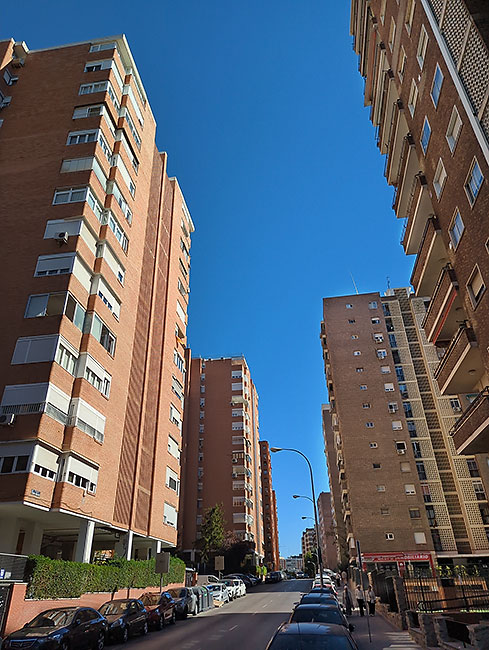A guiri I will always be, but today I am a guiri with a more typically Madrileño home. I moved far north of the colorful, historic central city, no longer stroll daily among rollaboard-toting visitors on Gran Vía, less often overhear tourists chatting in a farrago of foreign tongues at Puerta del Sol. I am surprised if I overhear English more than twice a month in my neighborhood, almost never see other guiris here, am occasionally eyeballed discreetly by locals.
Worth a post, I think, especially for readers who share an interest in what we transit fetishists call “transit-oriented development,” or TOD. Fewer than 150,000 live in that historic central city. The Madrid that expanded to include today’s 3.4 million (and nearly seven million in the greater comunidad) did so largely in newer, less picturesque, multistory housing that can deliver the bodies a brawny rail transit network needs to be practical. I’ll quote my immortal prose, from a 2018 post:
A Cercanías sightseeing ride through Madrid’s afueras shows me kilometer after kilometer of high-rise residential development: some of it ritzy, some of it run-down, but much of it straight out of a Transit Oriented Development textbook.
I now live among those kilometers, hoist this post online to offer first-hand testimony. What’s it like?
A LOT DEPENDS ON THE NEIGHBORHOOD
This has to go first.
Fortune has smiled on me. I have been lucky enough to settle in a nice area, am pleased by what I look at while strolling home from the metro station. (Although not during the April garbage strike.) That colors my perspective. Further, I didn’t take photos for this post in humbler barrios to give a more balanced view. This is a personal blog, not a news site. I dislike pointing even a smartphone lens at what strikes me as ugly (although I made an exception in Shanghai), feel a bit as if I’m mocking, leering. Fellow humans call these places home.
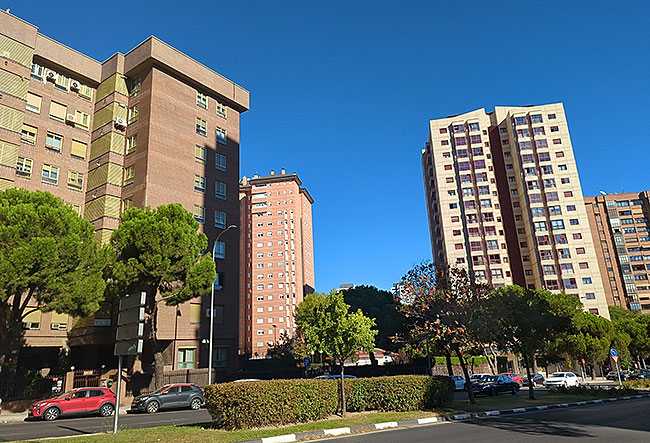
You can compensate for my negligence. Look up “Madrid’s poorest neighborhoods” in a search engine, fire up Google Street View, mouse around. You’ll find densely-built, transit-oriented, multistory, multifamily housing with barred lower windows and a lot that would delight me far less on those home-from-the-metro strolls (as well as high-rises overlooking the freeway). Please keep that in mind as you read.
(Although the neighborhood metro station itself will be nice. I’ve never seen anything here like the disgraceful Grant Avenue station in Brooklyn.)
MADRID TOD CO-EXISTS WITH CARS
Just for you, a photo of the Plaza de Cuzco glorieta in Chamartín. The mobility-minded visitor will at this glorieta find a 10 line metro station, dedicated north/south bus lanes, dedicated bike lanes, bicimad racks, a taxi stand, tree-shrouded pedestrian walkways … and on any weekday in la hora punta, armies of automobiles.
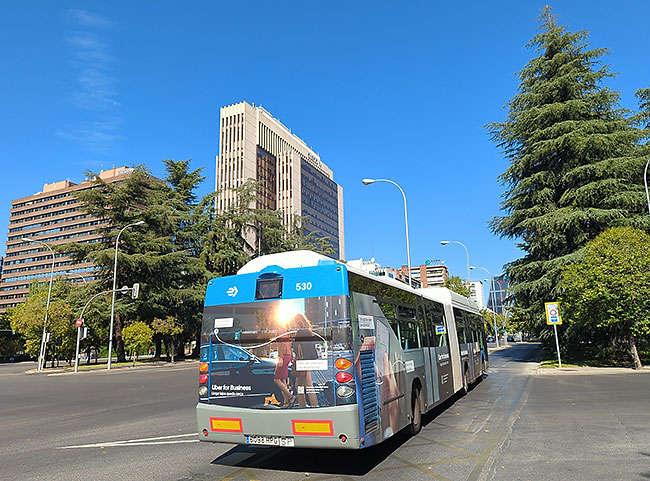
Transit is not stigmatized in Madrid as in most of the U.S. Madrid drivers chatted up at intercambios almost always know the time they save or lose with one transit mode or another. I infer that most would take transit if they could. But if they can’t, you’ll see them waiting for light changes at intersections like this. The strict traffic restrictions in historic Madrid Central are a special case.
The personal car generally plays a bigger role in transit as one moves farther from the city center (and not just in Madrid). Expect to see ‘garaje incluido’ in virtually all Idealista listings for Comunidad de Madrid towns like Colmenar Viejo and Tres Cantos.
PROBLEMS WITH CO-EXISTENCE WITH CARS
I can’t find stats to back me up, but am confident that double parking is much more common in Madrid than in San Francisco or Los Angeles. This might suggest that Madrileños are more tolerant of the practice.
Well, they aren’t. At all. Like a telegraph operator transcribing Morse code, I have learned to identify the outraged, impotent horn blasts of a motorist imprisoned between curb and delivery truck, with the delivery driver nowhere in sight.
MYSTERIOUS NEIGHBORS
My high-rise is faced, flanked and surrounded by other high-rise, multistoried kin. I can gaze from my living room at the windows of dozens of neighbors. Many will always be invisible to me; a surprising percentage keep their persianas drawn 24/7, may grouchily prefer the privacy of windowless caves to available views. Others never close persianas, seem content to live on stage. An easily-entertained busybody could while away hours at my windows after dark, snooping on neighbors as they wash dishes, prepare food, watch TV, hunker over evening meals.
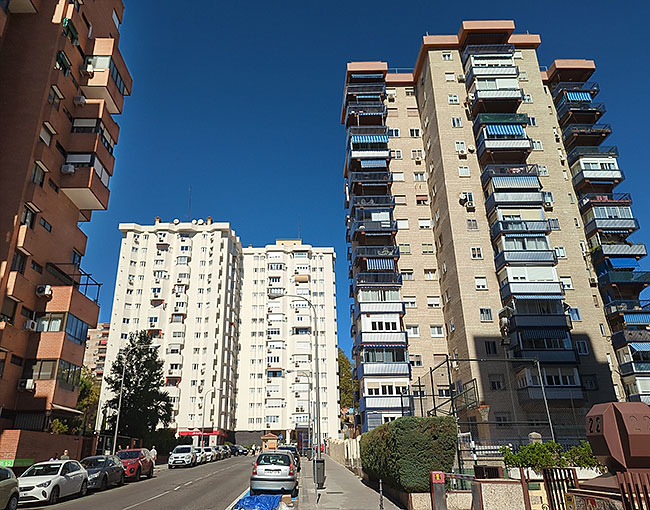
I see some faces regularly, particularly those of neighbors who are fastidious about cleaning windows. We avoid direct eye contact.
Madrid’s high-rises must offer droll tales of exhibitionists (perhaps exhibitionists who are bald, elderly, pot-bellied, inappropriately narcissistic) and fist-shaking crackpots, but I can offer no links.
Some of the high-rises originally included space in each unit for a narrow, rectangular outdoor balcony, perhaps on the assumption that residents would want to while away discretionary hours in open air and sunshine. A poor assumption, I think, as so many propietarios have walled their terraces in. The few who regularly avail themselves of their terraces may lounge, read and sunbathe in full view of their neighbors. Smokers also use terraces to feed nicotine addictions.
PERSIANAS
Wordreference defines ‘persianas’ merely as window blinds, or shutters, which I regularly raised and lowered inside residences in the U.S. But the persianas now familiar to me in Madrid are exterior blinds, often metal, which I never saw stateside. They’re all over the place here. I have them. Virtually everyone does.
UNDER-THE-COUNTER KITCHEN WASHER AND WASHER/DRYER
No photo in this post is likelier to inspire envy in a U.S. apartment dweller than that of this work-a-day washer/dryer. It’s not the what, it’s the where. The washer/dryer is in the kitchen.
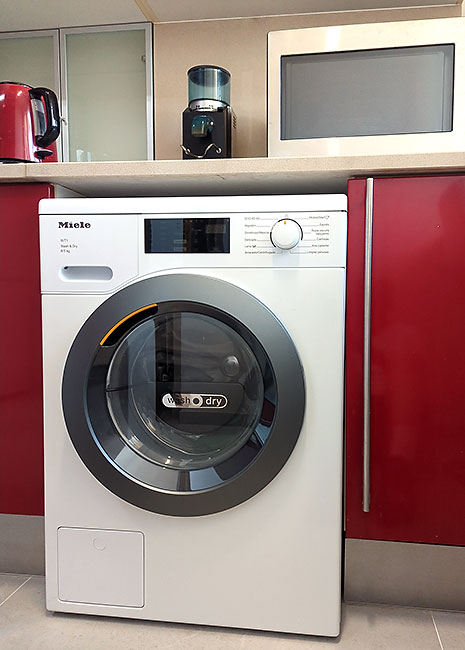
American apartments do not usually include washers. Residents expect to shlep dirty clothes to basement laundry rooms or commercial laundromats. Said shleps range from merely tedious to gruesome. No clean shirts for tomorrow’s job interview, you’ve already carted your half-as-heavy-as-a-corpse laundry sack to the basement three times today, and haven’t yet encountered a free machine. Or, Sandra Slacker gives you the evil eye for hauling her soggy clothes out of the drum and depositing them on the laundry room table, even though she left her wet pretties in the washer for three hours. Or, the building kleptomaniac STEALS YOUR CLOTHES. It happens.
But it likely won’t happen in Europe, as in-the-kitchen washers are common here. The drying cycle of such machines can take hours, but I have adopted the Spanish custom of draping clothes to dry on an interior tendedero. Some buildings include rooftop clothes lines.
EL CONTADOR
My unit includes discreetly-tucked-away meters for gas and water. A utility-company employee knocks on the door every couple of months for a reading.

If you don’t trust a stranger to tread daintily over your hand-knotted antique Persian rugs, you can open an online account with the utilities in question, submit readings online every two months, and explain your diligence to the door-knocking employee. He’ll be happy, and your rug will be, too, or at least as happy as a carpet is likely to feel about anything.
VENDORS WITH LOUDSPEAKERS
Every week or so, a vendor motors as slowly as he dares through the streets of my neighborhood, blaring a recorded sales pitch from a roof-mounted loudspeaker. Nothing similar beset me when I lived in central Madrid.
I am amazed that this is tolerated. I assume that the vendor is the only beneficiary, that thousands of innocent Spaniards do not thrill to the sudden din of a canned sales pitch while scrubbing the sink, dunking breakfast churros or doing whatever else they do in private at home. Most of us already have enough problems.
MIXED-USE DEVELOPMENT
In some parts of town. The Madrileño in Nueva España or Tetuán is likely to find markets, banks, restaurants and cafes within a couple of blocks of home. Other areas include fewer shops, strike me as almost pure bedroom communities.
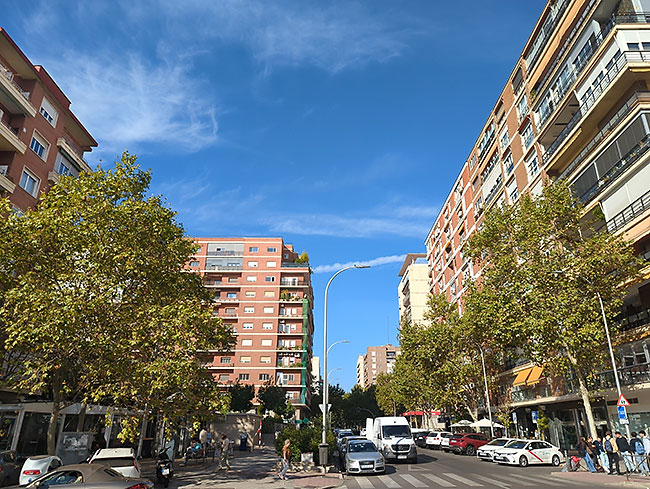
THE ALL-SEEING PORTERO
The portero works for a building’s property owners, but also may know much more about property owners’ habits and personal lives than even the nosiest neighbor in the American ‘burbs. It can’t be helped; the portero accepts deliveries, may take messages, watches residents’ ingress and egress from a desk by the entrance. Had the famously philandering past king Juan Carlos¹ lived in a Madrid high-rise, he might have struggled to sneak his serial paramours through the lobby. The portero might have snitched him off to the queen. The Zarzuela Palace was probably safer.
¹I just read Paul Preston’s biography of Juan Carlos, so shall conclude by working in an anecdote about the former king that has UTTERLY NOTHING TO DO with the rest of this post, as it’s worth telling and I won’t have occasion to mention it elsewhere.
His transgressions notwithstanding, Juan Carlos deserves enormous credit for steering Spain from dictatorship to democracy, and frequently endured small humiliations while doing so. When he flew on Iberia Airlines, for instance, right-wing Falange adversaries deliberately furnished the Prince of Spain only with sufficient funds to fly coach. A captain or aircraft purser often took pity on him, invited him into first class. Twice, this backfired; the Falange pilot entered the passenger cabin, told the future king to get his royal fanny back to coach where it belonged. A martyred Rodney Dangerfield of European nobility.
Check me up: page 249 of the Spanish edition, page 218 of the English edition.
Addendum: Madrid built dense TOD around a powerhouse transit grid. Densification of a city with an anemic transit grid will cram parking-slot-craving drivers into high-rises, with little practical alternatives to their vehicles. A 2007 article is still worth a read today.
